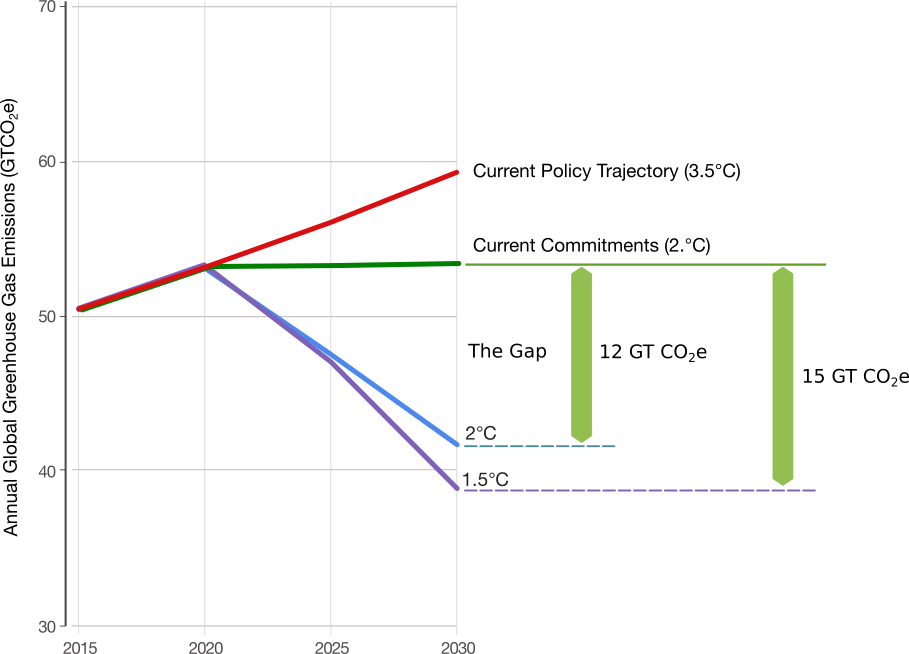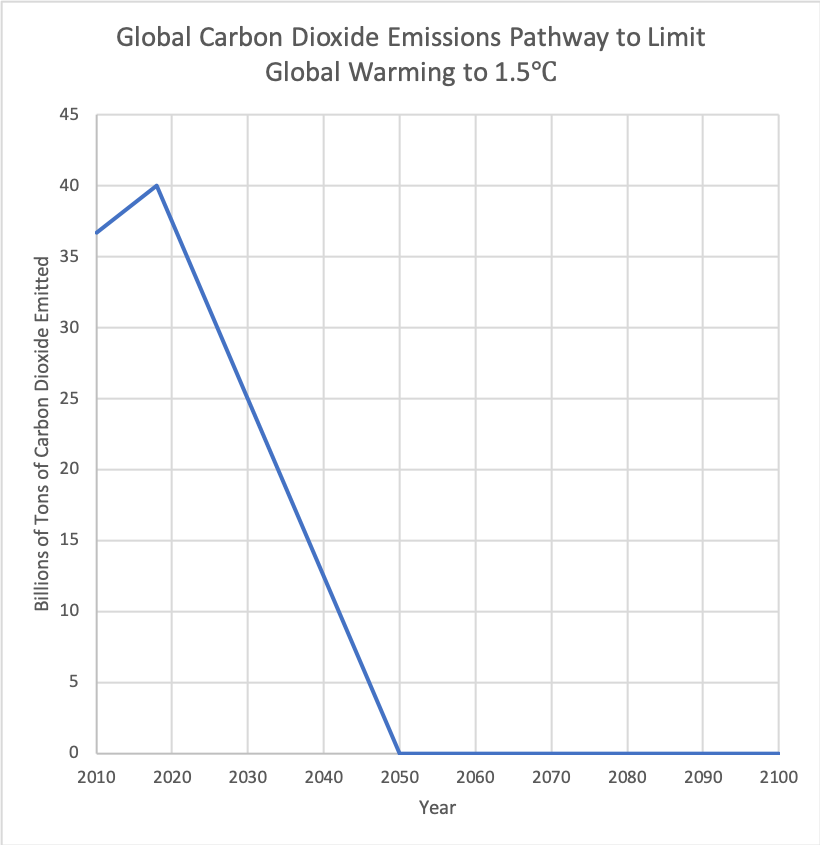So the world has finally come together and pinkie sworn not to let climate change get out of hand. In the Paris Agreement, the nations of the world agreed to take action to limit warming to well-below 2°C, 1.5°C if at all possible. What scale of action is needed to meet those targets?
We’ll rely primarily on two sources:
– The UNEP Emissions Gap Report, which tallies current and expected national emissions reductions and compares them to the 2 degree and 1.5 degree goals (The Gap), and
– Ratchet Success, an analysis by Climate Interactive, which outlines pathways to increase worldwide emission reduction goals in order to bridge The Gap.
The Pathway to 2 degrees

In 2014, global greenhouse gas emissions were 52.7 Gigatons CO2e. Emissions are currently increasing globally, though the rate has begun to slow.
In order to limit warming to 2 degrees C, by 2030 emission need to have decreased to 42 Gigatons CO2e (39 GT to meet the 1.5 deg target).
As the chart above shows, there is a wide gap between current global emissions reduction commitments and the level of cuts necessary to meet the stated goals of the Paris Agreement. UNEP estimates a gap in 2030 of 12 Gigatons CO2e for the 2°C goal, and 15 Gigatons CO2e for the 1.5°C goal.
The question that naturally follows is how to apportion responsibility for the still-needed emissions reductions. Given that current voluntary emissions cuts are not sufficient, how much should each nation increase their ambition? Answering this question requires finding a just and equitable way to apportion responsibility. There are several approaches to this, ranging from putting all of the responsibility on the people who historically caused this problem (i.e. the United States), to requiring each nation to contribute equally regardless of current or past emissions. For an excellent discussion of the common approaches and an in-depth evaluation of the level of commitment of each of the Paris Agreement signatories, visit Paris Equity Check.
Climate Interactive’s Ratchet Success pathway takes a middle approach, with developed countries taking the lead in reducing emissions in the near term, and developing countries ramping up their emissions reductions toward the middle of the century.
What does America’s contribution need to be?
In the Ratchet Success scenario, in order to keep warming below 2 degrees C, the US would need to reduce emissions to 45% below 2005 levels by 2030 (60% for 1.5 deg C), 80% by 2050, and from there down to zero by the end of the century.
US greenhouse gas emissions have been slowly decreasing for a number of years, but the rate is not nearly fast enough to prevent catastrophic warming. Our current NDC pledge is to reduce emissions by 26% by 2025. This is better, but still only half of the level of ambition that we really need to have.

What does that mean for me?
I’ll be discussing how these emissions reduction goals translate to individual experience/responsibility in later posts (in fact, it’s a major purpose of this blog in general), but for now, how about this for a goal:
Let’s each aim to meet the nation’s responsibility.
In future posts, I’ll be looking at how far individual action can get us toward the national target, what national/state/local actions will be necessary, and where to focus in order to achieve our personal goals. But if you’re an American wondering, “what’s my fair share of emissions reduction to stay within 2 degrees?”, the answer is:
50% less by 2030.
Cut your personal carbon footprint in half between now and 2030. That gives each of us 13 years to find the money/time/will/technology to do just twice as well as we’re doing now. 13 years is enough time to let cars and appliances live out their natural lives. When they do need to be replaced, buy one that’s twice as efficient as the worn out model.
It’s not a silver bullet. There’s more to the American economy than what can be directly influenced by individual consumers, even if we could get every citizen to participate. But if you’re a person who thinks it’s important to be doing your fair share of the work, this is your fair share.
Sources:
United Nations Environment Programme (UNEP), 2016. The Emissions Gap Report 2016. http://web.unep.org/emissionsgap/
Climate Interactive, 2015. Climate Interactive Ratchet Success Pathway: Assumptions and Results. https://www.climateinteractive.org/programs/scoreboard/ratchet-success-scenario/
Paris Equity Check. http://paris-equity-check.org
United States Environmental Protection Agency (EPA), 2016.Inventory of U.S. Greenhouse Gas Emissions and Sinks: 1990 – 2014. EPA 430-R-16-002. https://www.epa.gov/ghgemissions



